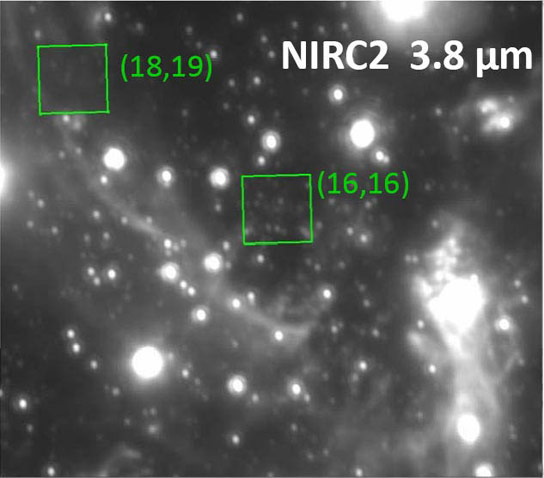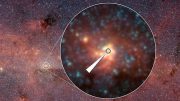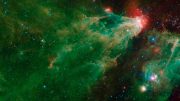
A near-infrared image of the Galactic Center – Sag A* region taken with the Keck Telescope NIRC2 camera using adaptive optics. Sag A* is not visible among its many bright neighboring stars. The central green square shows the size and position of the prime Spitzer IRAC pixel; the second square looks at a reference position. Spitzer’s pointing stability and very long duration observing sessions allowed astronomers to measure for the first time small fluctuations in the Sag A* flux over 23 continuous hours. Later this year the cloud G-2 is expected to encounter the Sag A* supermassive black hole and power much more luminous outbursts. Credit: J. Hora, IRAC, and NASA
Astronomers from the Harvard-Smithsonian Center for Astrophysics measure for the first time small fluctuations in the Sagittarius A* flux over 23 continuous hours.
The center of our Milky Way galaxy is located about twenty-five thousand light-years from Earth, in the direction of the constellation of Sagittarius. It is invisible to us in optical light because of extensive amounts of absorbing, intervening dust, but radiation at other wavelengths, including infrared and radio, can penetrate the veiling material. At the heart of the galactic center is a supermassive black hole, Sag A*, containing about four million solar masses of material. The region is actively studied by astronomers because the origin, evolution, and perhaps future of the Milky Way (including the solar system, which orbits the center every few hundred million years) are determined in part by the properties of the Galactic Center. Moreover, it is the closest galactic nucleus to us by far, enabling scientists interested in the bizarre nature of black holes to watch in detail, at least in principle, the physical activities underway in its immediate environment.
One problem – if you can call it that – is that Sag A* is relatively passive and dim, with only slight flickering seen and thought to be the result of small blobs of material randomly accreting onto a disk around it. This passivity distinguishes Sag A* from many other supermassive black holes that actively accrete and heat large amounts of material and eject powerful bipolar jets of fast-moving charged particles. Astronomers a few years ago were extremely excited, therefore, to spot a large cloud of gas (about three Earth masses) moving quickly towards Sag A*. Estimates projected that the cloud (known as G-2) might be “eaten” sometime around this summer, with the consequent accretion lighting up the region and permitting detailed modeling of black hole feeding mechanisms. Numerous groups began campaigns to monitor the activity of Sag A*.
CfA astronomers Joe Hora, Matt Ashby, Giovanni Fazio, Howard Smith and Steve Willner joined with seven colleagues to perform pioneering infrared observations of Sag A* using the IRAC camera on the Spitzer Space Telescope. Ground-based studies can only watch Sag A* during the night and so can never follow its activity for longer than about ten hours at a stretch. Moreover, Sag A* lies in a very crowded field of bright stars that must be spatially resolved to distinguish Sag A*. The latter problem has been successfully solved with large telescopes using adaptive optics techniques to ameliorate the effects of atmospheric twinkling, but the timing constraint remains. Spitzer, unlike ground telescopes, has no day or night, and can track a source for as long as it can store data onboard before transmission, as long as about 50 hours. The issue for the IRAC camera is the crowded field: as it stares at Sag A* even tiny telescope pointing wobbles will jostle the image of the field of stars slightly and so vary the total light falling on the prime pixel in a way that can be confused with accretion activity.
The astronomers were able to take advantage of the fact that, nearly eleven years after launch, today’s well-characterized Spitzer facility can reduce pointing errors principally to those induced by the spacecraft battery heater, corresponding to motions of only about five percent of one-pixel width. The tiny oscillations associated with this movement were readily detected by the team in the ripples of the pixel output, modeled, and resulted in their detecting variations of the Sag A* flux at roughly the few percent level. In their paper, which reports the first results of a multi-epoch observing program, the team did not see any evidence for G-2 accretion. However, they do see the normal small variations and for the first time were able to follow them for 23 hours. They were even able to determine some longer-term effects that indicate a deviation from random behavior. The implications, which are still being modeled, provide a baseline against which the G-2 encounter can be compared. Meanwhile, the team is currently working on six more observing sequences and associated papers.
Reference: “Spitzer/IRAC Observations of the Variability of Sgr A* AND THE OBJECT G-2 AT 4.5 um” by J. L. Hora, G. Witzel, M. L. N. Ashby, E. E. Becklin, S. Carey, G. G. Fazio, A. Ghez, J. Ingalls, L.Meyer, M. R. Morris, H. A. Smith and S. P. Willner, 15 September 2014, The Astrophysical Journal.
DOI: 10.1088/0004-637X/793/2/120









Be the first to comment on "Spitzer/IRAC Observations of the Variability of Sagittarius A*"